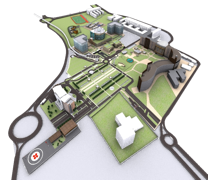Historically Labelled Living Labs
Since its formation in 2006 ENoLL has labelled 440+ Living Labs. See the full list of Labelled Living Labs who are not active members of the network.
 City of the Future Living Lab
City of the Future Living Lab
Innovation is the talk of the town, though ways to hone and foster it are complex and require a methodology that must continuously adapt and evolve.
For this reason, the “Center for Advanced Technology in Health and Well-Being” unit in the San Raffaele Scientific Institute (OSR) in Milan has set up the City of the Future Living Lab, with the aim of exploring the Living Lab methodology for the nurturing of innovation and the deployment of tomorrow’s eServices.
By involving users directly in the creation process (Co-Creation) eServices within a real city environment, a user-driven open innovation ecosystem was created thus bridging the gap between fundamental and applied research. By integrating the strengths and engaging the efforts of users, stakeholders, researchers, SMEs, large enterprises, institutions and policy makers, the City of the Future Living Lab is proving to be a successful breeding ground for disruptively innovative eServices, the foundations for future Smarter Cities.
In order to create true innovation, the Living Lab listens and observes users throughout the entire process of development and deployment of services with the aim of improving their mental, social, cognitive, physical and emotional well-being.
Description
San Raffaele Hospital in Milan has set up the City of the Future Living Lab, both a virtual as well as real research environment and community. The Living Lab is managed and organized by “Center for Advanced Technology in Health and Well-Being”, a department of OSR specialized in the application of Information and Communication Technology to health, with the aim of developing and delivering services to the hospital’s infrastructure as well as fostering innovation across numerous domains and disciplines. The Living Lab follows along the conceptual framework in which user-driven innovation is fully integrated within the co-creation process of new services, products and societal infrastructures.
The City of the Future Living Lab is an ecosystem where a multitude of stakeholders and partners work alongside each other, sharing knowledge whilst interacting with a wide variety of ICTs, therefore creating a fertile ground for innovation and cross-disciplinary research and communication. Indeed, the design process of services adopted within City of the Future Living Lab is based on three main drivers: Function, Emotion and Relation.
Function represents satisfying a person’s practical and basic needs through a service; Emotion is related to a service that enables a person’s psychophysical and emotional well-being; and Relation is a service that promotes social interaction among individuals and with their surrounding environment. In this way, the services created through the collaboration of a large multidisciplinary team, empower users to bring about positive changes that will improve the way they feed themselves, interact with one another, learn, move about and stay active.
Being situated within the San Raffaele Scientific Institute grounds allows the Living Lab’s team to build intense cross-disciplinary collaborations between medical and healthcare professionals, designers, engineers, policy makers, and entrepreneurs, across a number of different fields, from healthcare to well-being, from mobility and transportation to tourism. This unique ability of integrating healthcare, well-being, design, engineering and ICT is what differentiates City of the Future Living Lab from other Living Labs.
Another unique characteristic of City of the Future is that it embodies a City because its location and structure allows it to access, understand, study and measure the interactions among users (over 20,000 a day), health and well-being services that go beyond the walls of the hospital. The San Raffaele Science Park in Milan, covers an area of 300,000 and it can be described as a tertiary urban area, or a compact urban district that includes both newly developed and retrofitted buildings, where all daily and typical operations are concentrated in a reduced space.

The Science Park includes buildings with very different destinations:
 Agriculture & Agri-food
Agriculture & Agri-food
Since its formation in 2006 ENoLL has labelled 440+ Living Labs. See the full list of Labelled Living Labs who are not active members of the network.